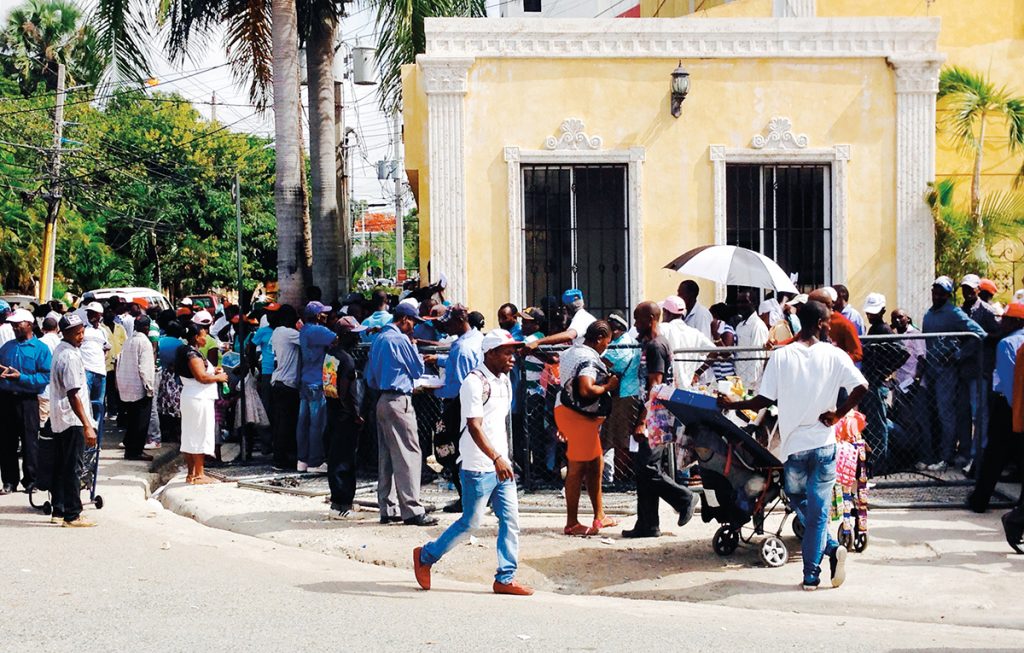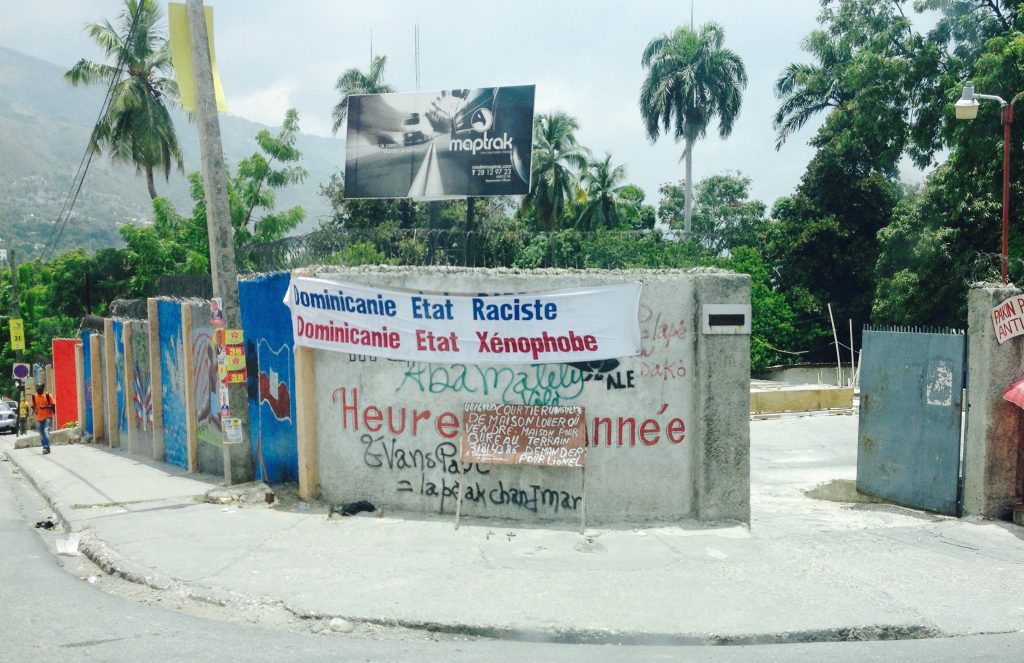STUDENT RESEARCH: CITIZENSHIP AND LIMBO IN THE DOMINICAN REPUBLIC

BY JOSÉ RUBIO-ZEPEDA
“I’m a nobody in my own country.” These are the words spoken by Juliana Deguis Pierre, a Dominican woman who made national headlines in the Dominican Republic after being denied Dominican citizenship despite having been born in the country. Deguis and other plaintiffs sued the government, with her case ascending to the Constitutional Tribunal, the Dominican Republic’s highest court. The case backfired, however. As of September 2013 the Tribunal (as written about extensively) retroactively stripped thousands of Dominicans of Haitian descent of their citizenship through ruling TC/0168/13, or “the Sentence,” as it became known throughout the world. Deguis’s citizenship was revoked by the decision, which claimed that her parents were in “in transit” when she was born. The new law applies to all Dominicans whose parents were not born in the Dominican Republic, and is retroactive for anyone born in 1929 or after. The law has left more than 210,000 individuals either stateless or in limbo. Many are like Deguis—with no family in Haiti, speaking little to no Haitian Creole, and ineligible for Haitian citizenship.
Statelessness is the inability of an individual to be considered a citizen by any state through its nationality legislation or constitution. Stateless individuals face the overwhelming challenge of “existing without an acknowledged identity.” Those who are stateless or in limbo, as thousands of Haitians and Dominicans of Haitian descent continue to be, are not legally able to marry, work, have a bank account, obtain a driver’s license, vote, register for high school or university, or even buy a cell phone through one of the major cell phone carriers, as this all requires a cédula or national ID. Without proper documentation, their lives become perilous. In the short story “Ghost,” Haitian-American author Edwidge Danticat explores the dangers of statelessness through the protagonist, Pascal, whose quest to become a radio journalist leads to confusion over his involvement in a shooting, followed by questioning and treatment as a criminal for his reporting on police corruption. Danticat metaphorically represents Pascal as a ghost, similar to the Haitians who navigate their way through Santo Domingo and the Dominican Republic as transitory ghosts. This transitory status could also be described as a liminal one. Liminality, as defined by Maurice L. Hall and Homi Bhaba, is an “in-between,” transitionary space that may affect individuals’ identities—whether race, ethnicity, class, gender, or sexuality—a space neither here nor there. In the case of Haitians and Dominicans of Haitian descent, their physical presence and the space they occupy, whether in the capital city or elsewhere throughout the Dominican Republic, becomes contested, or liminal. Liminality can also affect how these individuals navigate public versus private spaces, and the ways in which they’re included in the Dominican Republic, but also excluded. What aspect of these individuals becomes valued?
As with many other immigrant groups, what becomes valued are the bodies of Haitians and Dominicans of Haitian descent, specifically, the labor they provide to the Dominican economy. They occupy a vulnerable socio-economic position within the economy, working in the informal sector as street vendors (harvesting and selling fruits and vegetables, or candy), as market vendors (selling clothes or an array of household items), and most often at construction sites (written about extensively by Petrozziello 2013 and Wooding et al. 2004). Because of the jobs they are able to obtain, and the lack of protections they have, their labor becomes commodified. This commodification of labor, however, is not unique to Haitians or Dominicans of Haitian descent, as it is reproduced in other countries, particularly those of the Global North.
An Island Divided
The Dominican Republic’s economy is eight times the size of Haiti’s. This wasn’t always the case, however. Until the turn of the twentieth century, Haiti was wealthier than the D.R. Under colonial rule for centuries, the island of Hispaniola was a possession divided between the French and Spanish. Haiti, proudly the first slave society to overthrow its overlords in 1791, became the second republic in the Western Hemisphere, after the United States. Two decades afterwards, in 1825, France surrounded the country with gunboats and extorted it, demanding 150 million gold francs in compensation for “lost property”: slaves. Haiti was then forced to borrow money from French banks in order to meet deadlines to pay off this “debt,” which it wasn’t able to do until 1947, after 122 years.[1] This is one of the reasons for Haiti’s status as the “poorest country in the Western Hemisphere.”

Haiti ruled the Dominican Republic—at the time known as Santo Domingo—from 1822 until 1844. These dates have left an indelible mark on Dominicans as one of the most humiliating episodes in their country’s history. Dominican Independence Day is, in fact, not celebrated on the day the D.R. obtained its freedom from Spain, but on the date of independence from Haiti. Into the twentieth century, the border between the Dominican Republic and Haiti remained porous. In 1937, a massacre of Haitians ordered by Dominican dictator Rafael Trujillo decisively marked the differences between a black Haiti and a Hispanic Dominican Republic. Upwards of 20,000 Haitians died in the Parsley Massacre along the Dominican-Haitian border on the Artibonite River, also known as the Massacre River, a site of conflict between the two nations. The massacre realized the anti-Haitian project of many Dominican nationalists, who regarded the country’s black heritage as detrimental to national development. Dominicans instead evolved a national culture that denied or deemphasized their African roots. This racial ideology, dominicanidad (Dominicanness), celebrated the European roots and rejected the African, taking pride in Hispanic heritage and Catholicism. Thus, by virtue of their early independence and rebellion against slaveholders, Haitians created a national culture on race, while in contrast Dominicans created a national identity based on culture, rejecting the role of race. Dominican racial mythology built a silence around blackness, reaching back to pre-Columbian Indigenous cultures and developing a rich vocabulary of color hues to describe phenotypes that were ascribed to Native Americans.
Factors Contributing to Migration
The driving force behind the exodus of Haitians to the Dominican Republic is poverty. The first large-scale migration dates back to the 1920s, but migration to the D.R. is just as prevalent now. Haiti remains the poorest country in the Western Hemisphere and one of the poorest in the world, with considerable needs for basic services and resources. Annual income per head of household is around US$820,[2] yet according to the World Bank, Haitians subsist on incomes far below that (an estimated 80 percent) and many live in abject poverty. The latest household survey was conducted in 2012, with more than 6 million out of 10.4 million (59 percent) of Haitians living below the poverty line on the equivalent of US$2.42/day, and over 2.5 million (24 percent) living on US$1.23/day. Ecological disasters since the 1970s, including most recently the 2010 earthquake, have fueled the rise in poverty. Unemployment and a stagnant economy have been linked to chronic political instability characterized by “troubled relations” with international financial institutions. Successive dictatorships that lasted until 1986, along with periods of coups (1991 and 2004), have contributed to the political upheaval that also drives mass migration of Haitians across the Dominican border.

June 2015 marked the deadline for Dominicans of Haitian descent to register and attempt to establish legal residency. As of this writing, fewer than one-third of the estimated 210,000 who were left stateless by TC/0168/13 have been able to successfully reclaim their citizenship. A common problem is that children of Haitian migrants or Dominicans of Haitian descent had not had their births recorded in the civil registry. Will these children and others continue to become “transitory ghosts”? The recent reelection of President Danilo Medina in the D.R., although still contested, means that the ruling PLD (Dominican Liberation Party) will extend its twelve-year rule until 2020, with current citizenship policies likely to endure. What will become of those who remain undocumented or were not able to register? How will Haiti, with its current political unrest and uncertainty, continue to exacerbate the migration of Haitians to the Dominican Republic and other countries? The answers remain to be seen. However, if neoliberal policies and discriminatory laws continue to favor a select few—namely, Dominican and Haitian elites—the island of Hispaniola will remain divided and the tensions between the two countries will live on for years to come.
José D. Rubio-Zepeda is a third-year master’s degree candidate at LLILAS pursuing a joint degree in community and regional planning. He holds a bachelor of arts in political science and Spanish with a minor in international studies, Latin American emphasis, from the University of Wisconsin–La Crosse.
Notes
[1] Kim Ives, “Haiti: Independence Debt, Reparations for Slavery and Colonialism, and International ‘Aid’,” Global Research (May 10, 2013).
[2] “Haiti,” The World Bank (2016).
References
Hall, M.L. 2007. “The Postcolonial Caribbean as a Liminal Space: Authoring Other Modes of Contestation and Affirmation.” Howard Journal of Communications, 18(1): 1–13.
Ferguson, J. 2003. Migration in the Caribbean: Haiti, the Dominican Republic and Beyond (Rep.). Retrieved May 1, 2016, from Minority Rights Group International website.
Kosinski, S. 2009. “State of Uncertainty: Citizenship, Statelessness, and Discrimination in the Dominican Republic.” Boston College International and Comparative Law Review, 32(2): 377–398.
Nolan, R. 2015. “Displaced in the D.R.” Harper’s Weekly. Retrieved April 2016.
Petrozziello, A.J. 2012. Haitian Construction Workers in the Dominican Republic: An Exploratory Study on Indicators of Forced Labor (Rep.). Retrieved May 2016 from ICF Macro, Inc. website.
Turits, R.L. 2002. “A World Destroyed, a Nation Imposed: The 1937 Haitian Massacre in the Dominican Republic.” Hispanic American Historical Review 83(3): 589–635.
Wooding, B., R.D. Moseley-Williams, M. Arregui, D. Paiewonsky, International Cooperation for Development & Jesuit Refugee Service. 2004. Inmigrantes haitianos y dominicanos de ascendencia haitiana en la Républica Dominicana. Santo Domingo: Cooperación Internacional para el Desarrollo (CID).
